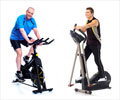
‘Heat-dissipating compression garments did not improve the performance of athletes but lowered it. This clothing was also found to have the potential to increase heart rate after an intense effort.’
Tweet it Now
There are two main strategies of proven effectiveness when it comes
to preventing health problems and fighting against the reduction in
performance in hot atmospheres: heat acclimatization and rehydration. In recent years, many other strategies have also been explored to reduce and/or delay increases in core (or internal) temperature and therefore enhance sports performance. Strategies ranging from ice water baths to the intake of slushies including the application of bags filled with ice or the use of compression clothing, among others.
Heat-dissipating clothing and sweat efficiency
Specifically, manufacturers of this heat-dissipating compression clothing assure users that it offers temperature-controlling benefits when the heat dissipates as a result of an improvement in sweat efficiency. Yet so far there have been no studies supporting these claims of compression clothing for the upper part of the body where most of the sweating takes place.
In his thesis, Iker Leoz has investigated the validity of a type of compression garment designed to dissipate heat as a strategy for reducing increases in body temperature during exercise in various environmental conditions and in the healthy and physically active population.
Advertisement
The studies ran showed that the use of heat-dissipating compression garments offers no temperature-controlling benefits in physically active young people during moderate exercise at a temperature of 20 oC, even though during passive recovery the use of garments of this type could help to lower body temperature.
Advertisement
In the case of trained cyclists with an average age of 66, garments of this type increased body temperature. For this reason Leoz recommends that this population should not use heat-dissipating compression clothing, as it could increase the onset of hyperthermia (raising of body temperature above the normal levels).
The study into intense efforts (treadmill bout to the point of exhaustion) revealed that heat-dissipating compression garments not only did not improve the performance of recreational runners but also lowered it. This clothing was also found to have the potential to increase heart rate after an intense effort. "Recreational cyclists should be made aware of the possible adverse effects of this type of clothing," said the researcher in his thesis.
Source-Eurekalert









